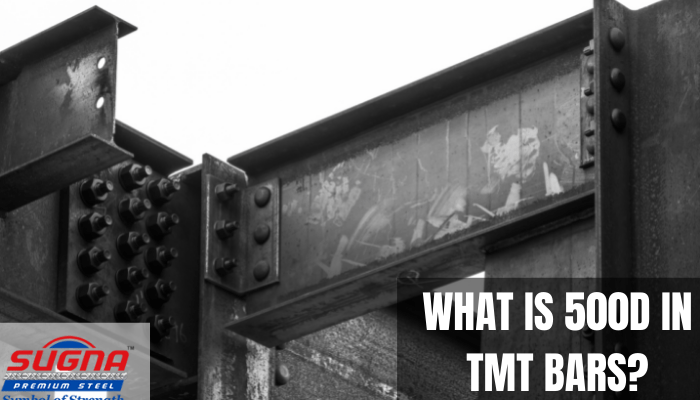TMT Steel Bars are used in many fields. Some of them are listed below.
TMT Steel Bars Applications
1. Structural Framing.
2. Suspension Systems.
3. Heavy Machinery Components.
4. Hardware.
What is 500d in TMT bars?

If you are working on the construction of your property, then you must hear the word 500d TMT Bars. Do you know what it actually means? Let’s tell you.
The term Fe 500d refers to the minimum yield stress in steel bars. Here d is the Mpa and Fe refers to the iron content. A TMT steel Bar is a steel bar with a rectangular cross-section having 2 slots machined along the length. The slots prevent strains from occurring in the bar by providing clear paths for material movement during fabrication, transport, and use.
What does d denote?
The d in 500d represents. Mpa. For many construction-related applications, steel bars are used as reinforcement for concrete components.
The minimum yield stress of steel bars is a factor in the design of these structures and is typically set at 1,000 psi or higher. In some cases, the minimum yield stress may be as low as 50 psi with an ultimate tensile strength that can reach over 25,000 psi.
The minimum yield stress of steel bars varies depending on their dimensions and length. The larger its diameter and length, the greater its ultimate tensile strength will be because it has more cross-sectional area to support compressive forces.
What is the minimum yield stress of steel?
Minimum yield stress in steel bars is the amount of load required to produce a bar that has a yield point. Steel can deform by plastic (solid-state) or elastoplastic (dynamic) behavior.
Minimum yield stress rarely occurs in solid-state deformation as no strain gradient exists and the overall shape of the material remains unaffected during solid-state deformations. Minimum yield stress is determined by the onset point of plastically deforming, one-dimensional, homogeneous, isotropic, elastic-perfectly plastic materials.
A material is considered to be plastically deforming when it experiences a strain greater than the yield point strain. This phenomenon occurs at various levels of stress depending on the strength of the material. As there is a wide range of strengths in different materials and alloys, it is important to know what level of stress and strain is required for minimum yield stress to occur.
Conclusion
Steel has two important performance attributes: its strength and ductility. The strength of steel is related to the minimum yield stress (MYS) in steel. MYS is the lowest load that a piece of steel can be subjected to without fail.
It depends on many factors, including elasticity, surface finish, thickness, mechanical properties such as hardness at a given temperature or tensile strength, and elongation at break. The mechanical properties of steel define the ability of steel to deform under various loads.
Ductility, on the other hand, is the ability of a material to recover its original shape after being deformed. The MYS and ductility are both important in determining the properties and performance of steel.
It is measured by a tensile test where the tension of force is applied to the steel and the elongation of the specimen is measured as it deforms and bends it involves both elasticity and ductility.

